Investing in LEGO is an interesting offshoot of the LEGO hobby that has been getting more and more attention not just from LEGO fans, but also the general public. The fact that all LEGO sets have a limited production run and get retired at some point, makes them ideal collectibles. And whenever there is a collectible market, there is also an opportunity for short-term resellers and long-term investors…
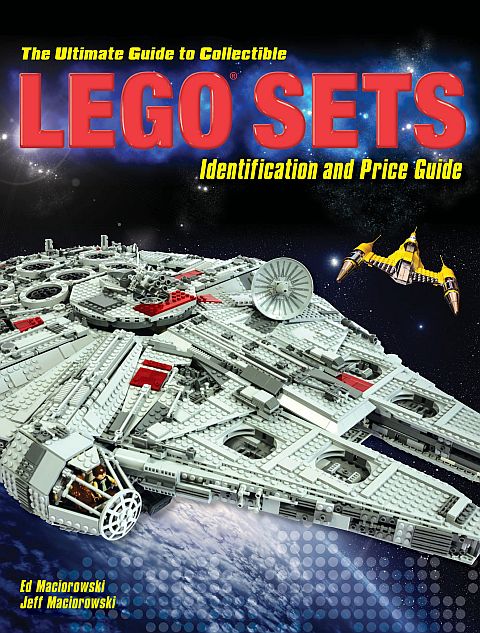
Because of LEGO’s quality, durability and timeless design, collections changed hands even in the past; usually passed down from one generation to another. It was with the advent of the internet – specifically online marketplaces and auction sites like eBay – that LEGO started changing hands over larger distances, even around the globe. The internet also opened up the opportunity for LEGO fans to share their creations, which quickly established that LEGO is not just a toy for little kids, but a medium of art and design for adults. The popularity of LEGO as a serious hobby for teens and adults further fueled the demand for both old and new LEGO sets, bulk lots, and individual pieces. Joining eBay as the place to buy and sell LEGO, the unofficial online LEGO marketplace BrickLink.com was born, solely focusing on facilitating LEGO buyers and sellers. In the meantime the LEGO company itself was going through some major changes that accelerated their popularity and growth, eventually becoming the number one toy maker in the world in 2013.
Prices on retired LEGO sets skyrocketed to hundreds – even thousands – of dollars on the secondary market. Those who were fortunate to have these older sets were making a killing, with as much as 1,500% return on their original investment. But early investors in LEGO were few and it was more based on sheer luck of having a particular set. All of this expansion and growth however made LEGO a very attractive option for resellers and investors even from outside the hobby, especially in an otherwise slumping economy. Now that more people are aware of the LEGO market, it is unlikely that we will ever see those kind of returns, but because LEGO sets still have a limited lifespan, and there is still strong demand for out-of-production sets, there is plenty of money to be made. In fact, a lot of people consider LEGO a safer investment with better returns than the stock market.
Brothers Ed and Jeff Maciorowski started paying attention to the LEGO secondary market about seven years ago, amazed at the prices people paid for retired LEGO sets. They launched an online LEGO investing and price-guide called BrickPicker.com. We have talked about the site before (see links at the end of this post), but to summarize briefly, BrickPicker.com follows the prices of LEGO sets on eBay, and aggregate the data into very helpful charts and price-guides – much like what you would see on stocks and commodities. BrickPicker.com also has a very active forum, a blog with helpful articles on LEGO investing, and other features that LEGO investors can take advantage of. And now Ed and Jeff published a book titled: THE ULTIMATE GUIDE TO COLLECTIBLE LEGO SETS – IDENTIFICATION AND PRICE GUIDE
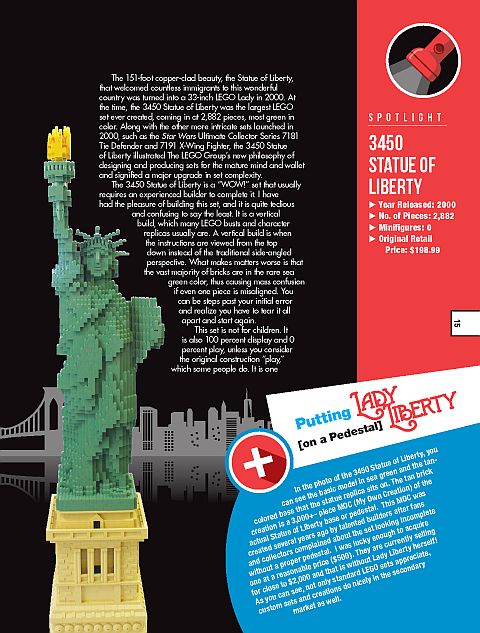
➡ HERE IS THE OFFICIAL DESCRIPTION OF THE BOOK: LEGO bricks are the building blocks of childhood. Yet they are far from child’s play. LEGO sets are fast becoming a hot commodity with collectors worldwide for fun and profit. Abundantly visual, informative and detailed, The Ultimate Guide to Collectible LEGO Sets is the definitive reference to more than 2,000 of the most collectible sets on the secondary market, illustrating the incredible value of LEGO bricks, not only from an entertainment and educational standpoint, but also as an investment. Consider a Star Wars Ultimate Collector Series Millennium Falcon, which sold at retail for $500, is now selling for more than $3,500 on the secondary market. The Ultimate Guide to Collectible LEGO Sets features: More than 25 top themes, including Advanced Models, Batman, Ideas/Cuusoo, Star Wars UCS and non-UCS sets, Technic, Trains, and Vintage. Up-to-date secondary market prices for more than 2,000 new and used sets from 2000 to present. More than 300 full-color photos of sets in their boxes, and built models. Tips on reselling, flipping, and investing. The Ultimate Guide to Collectible LEGO Sets is your brick-by-brick guide to a world of imagination and discovery.
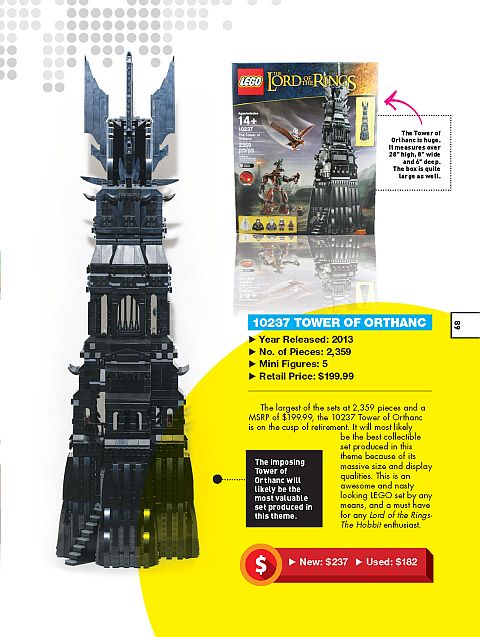
➡ ABOUT THE AUTHORS: Ed Maciorowski is the co-founder and co-owner of BrickPicker.com. He has been a LEGO collector since 1973, when his parents gave him his first set (710 Wrecker with Car). Ed is now an investor as well, with over 6,000 sets in his collection and a current market value well into the six figures. He and his brother, Jeff, got the idea to create the online LEGO price and investing guide after Ed discovered that a #10179 Millennium Falcon set he bought for $399 was selling for $800-$1,200 on eBay two years later. The price for that set is now nearly $4,000. Ed also is a regular contributor in the LEGO-themed magazine, BLOCKS.
Jeff Maciorowski is the co-founder and co-owner of BrickPicker.com. He is a senior website engineer for a $40 million market research company and specializes in multiple web technologies, including Cold Fusion, jQuery, Oracle, and mySQL. Jeff built Brickpicker.com from the ground up and it is now the third busiest LEGO-themed website in the world that attracts over five million visitors annually. The site has been featured in the USA Today and other digital media outlets (BBC.com, Wired.com). Jeff is also the creator of the recently launched BrickClassifeds.com website, a cost-effective secondary LEGO marketplace.
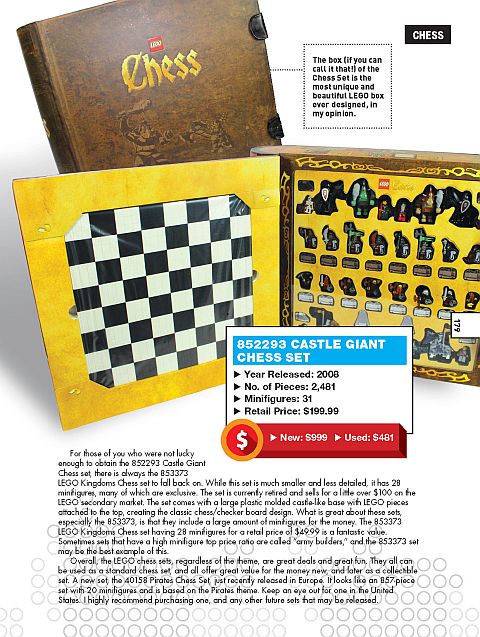
I know that the history lesson on LEGO investing was a bit long-winded (I tried to make it as short and concise as possible), but I felt it was necessary to impress upon you why this book is so essential, if you want to play in the LEGO reselling and investing field. As I said, money can still be made, and the LEGO market will likely continue to expand, but the game is tighter and less forgiving, so having expert guidance can save you from making costly mistakes. Which brings us to the question…
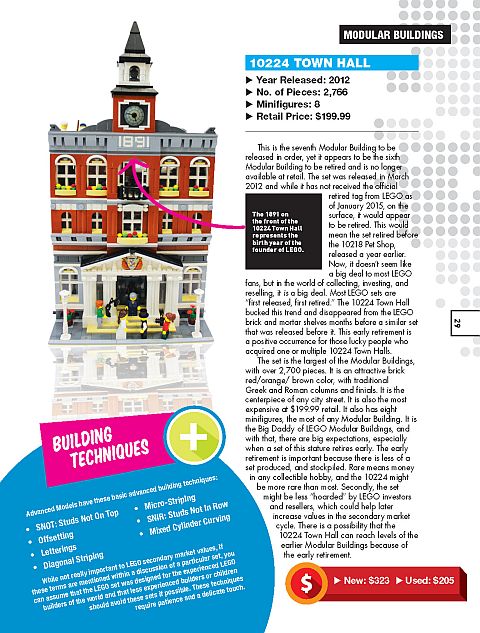
➡ WHO THIS BOOK IS FOR: If you don’t want to get deeply into LEGO investing, but you have some old LEGO sets in the attic or garage you would like to get rid off, this book is for you. It will maximize your chances of getting a fair price for your collection by using the Price Guide and other data…
If you are into LEGO’s history this book is for you also. The Ultimate Guide to Collectible LEGO Sets is much more than just a dry investment book with charts and numbers. It is divided up by chapters of all major and even some minor LEGO themes, and goes into detail about their history. The focus is on LEGO themes and sets that have been performing well price-wise on the secondary market, but examples are also given on themes that didn’t do well. It is a fascinating read…
If you would like to sell LEGO to support your hobby with quick flips, or if you would like to invest in LEGO for the long term, this book is a must. Through examples it will teach you how to spot winners and how to avoid losers, and in general become a savvy LEGO investor. The book has a mix of a narrative style so it is an interesting read, while also providing facts and numbers to look up the value of a particular set quickly…
And if you are looking for older LEGO sets that you missed out on, this book can guide you on what is the fair market value of those sets. You can also use the book to find bargains on retired LEGO sets that didn’t perform well as an investment and now investors want to get rid off.
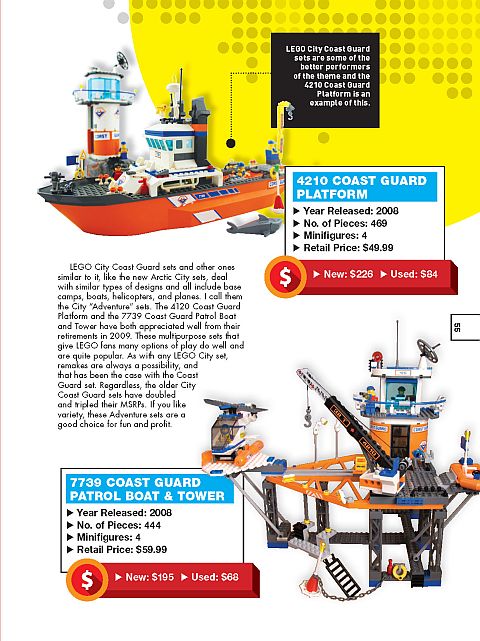
➡ HOW THE BOOK IS ORGANIZED: The Ultimate Guide to Collectible LEGO Sets is divided into chapters by major LEGO themes. Each chapter starts with an overview of the theme, particularly from the view of its investment value. Then on the following pages several examples are given from that theme. The best performing sets are analyzed in detail to give you an understanding of why they are good investments. And there are also examples of themes that haven’t been doing well on the secondary market, and these are analyzed as well. This is particularly important because new LEGO sets are constantly being produced while older ones are retired, and learning how to evaluate them is an important skill. 200 pages of the book are dedicated to analyzing LEGO themes and sets in this fashion
The last 50 pages of the book contain the Price Guide, which is based on sold auctions on eBay, just like on the BrickPicker.com website. Not all LEGO sets are included in the book version of the Price Guide because that would be a list of over 10,000 sets, however all the major LEGO themes are listed along with the important sets within that theme. The book version of the Price Guide is an excellent quick reference, and to get the most up-to-date information you can visit BrickPicker.com.
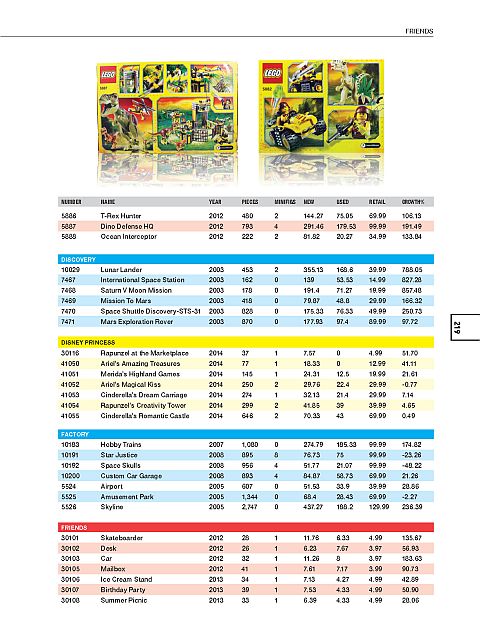
➡ WHAT I LIKED ABOUT THE BOOK: There is a lot to like about this book. I originally thought I will just flip through it to write this review, but then I got so absorbed, I found myself reading it page by page. The book was obviously written by people who are deeply in love with the subject, and could talk for days about every nuance of investing in LEGO. The authors could have easily gone overboard and make the book unnecessarily long and complex, but they didn’t. The book is well organized and the information is shared in small and easy-to-digest chunks. If you want to quickly look up the evaluation of a set you can do that, and if you want to delve into it deeper to understand the pricing, you can do that too. The text is large enough for easy reading, and important information is highlighted in boxes on each page. Also, I appreciate that pictures of the real sets were included, not just box-art.
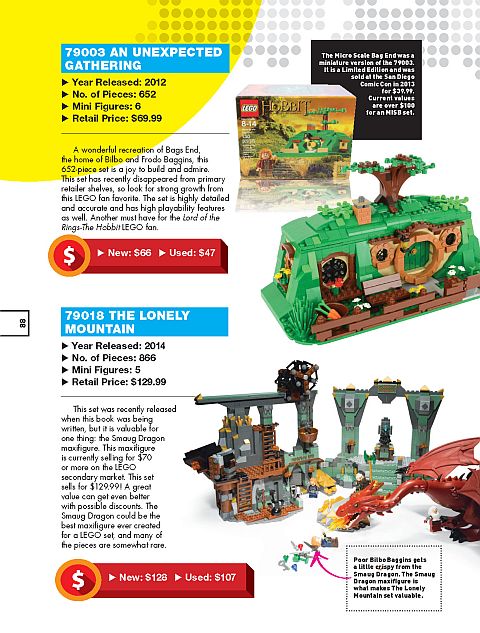
➡ WHAT I DIDN’T LIKE ABOUT THE BOOK: There is nothing I strongly didn’t like, only a few things that I thought could have been done a bit better. I would have liked a list of the sets that are discussed in each chapter on the main page of the theme. A list is available in the index, but it would have been nice to have them in each section as well – kind of like how many cookbooks are organized. I would have also liked a more consistent placing for the quick info boxes on the pages, so when flipping through the book quickly they are all positioned in the same place.
It would also have been nice to include not just the year of release, but the year of retirement as well. I know this information is not easy to find on older LEGO sets, but it is crucial to investors to understand how the LEGO market works. I would have also liked some blank lines on set pages to take notes. I have already started adding sticky-notes to the pages to update prices and other information, but it would be nice if there is a dedicated place for personal notes right in the book. For investors this is going to be a book they will flip through often, so anything that can make the book more hands-on and interactive helps.
Reference to LEGO colors throughout the book is inconsistent, often on the same page. So for example the same shade of green is called both sea-green and sand-green. While this may seem minor, in the world of LEGO investing knowing colors is important. Some colors have a much higher value on the secondary market, while others are very common and not worth that much. Knowing this gives you more options. A set that may not appreciate as much as you have hoped for, can be parted out to sell the pieces individually. For sets with rare colors this often gives you a better return.
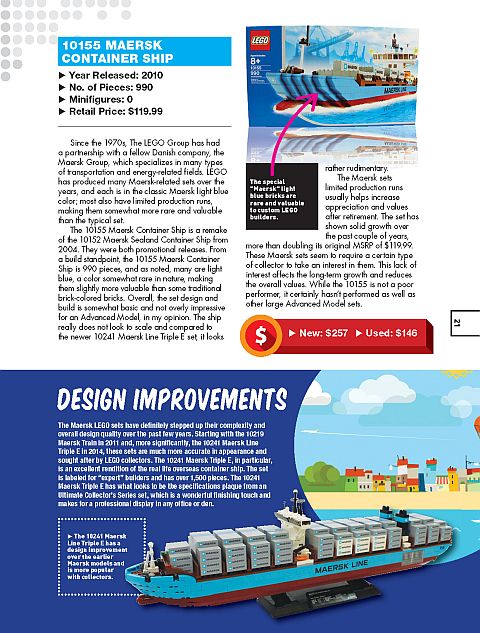
All in all, The Ultimate Guide to Collectible LEGO Sets is phenomenal, and fills an important need. Investing in LEGO is still a fairly new development with not much guidance out there, so it is easy to get confused or feel overwhelmed. In addition, investing is LEGO is also a somewhat controversial topic and finding the right information can be difficult. But whether you just have a few LEGO sets you want to get rid of, or you want to become a full time LEGO investor this book will start you on the right path. If you are interested to check it out, the book is available on Amazon here: THE ULTIMATE GUIDE TO COLLECTIBLE LEGO SETS ON AMAZON
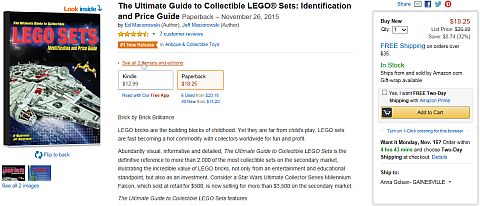
Also, I would like to mention that while the book focuses on buying and selling on eBay, which is undoubtedly one of the largest marketplaces in the world, it is also worth checking the prices on BrickLink.com, the largest marketplace exclusively for LEGO, as sometimes prices can differ quite a bit. In fact I know LEGO resellers who buy on one site and sell on the other. BrickPicker.com itself has its own marketplace called BrickClassifieds.com. This is a fairly new venture, but it already cemented itself as one of the premier online LEGO marketplaces, and has been embraced by knowledgeable LEGO buyers and resellers as a great alternative for listing their LEGO related items. And the best part? They charge no commissions, which benefits both buyers with lower prices and sellers with lower costs.
If you have been considering getting into the LEGO buying and selling game, I hope you found this review helpful. Feel free to share your own thoughts on the topic on LEGO investing in the comment section below. And if you have any questions about the book, feel free to ask them! Ed and Jeff are happy to answer them for you. 😉
And you might also like to check out the following related posts:












That sounds really interesting. Thanks for the detailed review. I have used brickpicker a few times, but having a book on investing can be very useful also. The price guide at the back of the book would get outdated quickly though, isn’t it?
You can get updated information from the online version of the Price Guide that is available on the BrickPicker website. I actually found that having a static Price Guide is quite helpful too. It allows you to track how the prices change over time, which is a valuable lesson in itself. This is especially useful if you are planning to invest in LEGO. For example knowing how long it takes for the Modulars to double in price after retirement can be a very useful information.
Great detailed review. I have this book and enjoy it very much. The book offers great content and design. While I wouldn’t describe myself as a collector, the collecting and investing advice is very insightful and helpful. Unlike a lot of other LEGO books on the market, The Ultimate Guide to Collectible LEGO Sets goes well beyond the ordinary, providing critical thinking, great images, design, a good dose of fun and values. I am finding the descriptions, information, investing trends, etc., just as valuable as the pricing. And while the pricing may get dated, the other information won’t. Highly recommend.
Yea its pretty cool it gives you all the details you could ever want about buying cool sets